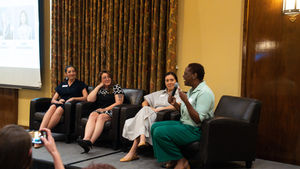GROWTH AND CHANGE: Becoming Central Texas Grantmakers
- Impact Austin
- May 12, 2023
- 4 min read
Updated: May 15, 2023

In celebration of our 20th year, Impact Austin looks back on challenges and opportunities that helped us to grow and mature as a circle of women philanthropists and a collective giving grantmaker in Central Texas.
One hallmark of collective giving groups like ours is that member-volunteers facilitate the organization's grantmaking. Most often, members (not staff) solicit, evaluate, and follow up the giving circle's grants. Many groups construct a formal vote to choose each year's grants; some simply enact the final decisions of their grant review committees. Either way, the process educates giving circle members about community needs, the nonprofits serving them, and how philanthropy can support both.
The Impact 100 Model
While Impact Austin's founding board recruited women to join, they had to simultaneously develop a grantmaking program that was ready to launch once our 100+ member goal was met. They adopted the basic framework of the Impact 100 model in Cincinnati wherein grants of $100,000 or more would ultimately be awarded across five broad focus areas: Culture, Education, Family, Health & Wellness, and Environment. But Impact 100's leader Wendy Steele did not share the details, policies, and procedures of their grant practices, urging that Impact Austin should create its own program that would fit its own membership. That challenge was taken up by founding board members Glenda Holmstrom and Melissa Gray (who Glenda suggests should be the honorary 7th member of the Kitchen Table Six). Glenda insists that neither of them - nor anyone on the founding board - knew anything about grantmaking! Melissa had worked as an attorney, and Glenda had been on business acquisition teams, so due diligence and research were familiar to them both. Melissa added, "Glenda and I had no doubt that we could figure it all out, but we were determined to do more than that. We wanted to create a process that was thorough and lasting."
Glenda and Melissa had very few giving circle peers to consult. Impact Austin was an early adopter of women's collective giving, after all. Instead, Melissa and Glenda researched foundations (women's foundations in particular) and other funders. The Washington Women's Foundation was particularly helpful, and they gleaned much from that group's process. They downloaded forms from the internet. They read books on grantmaking. Barry Silverberg, Director of the Center for Nonprofit Studies at ACC, was very helpful. "We researched it like crazy," Glenda stated. "We just did a very deep dive into grantmaking and pulled out the best of it for Impact Austin." Both women felt the responsibility to develop "an ethical, transparent process accountable to members and nonprofits, giving them all a quality experience." Glenda added, "We wanted to established credibility with our members [who had donated $1,000+ each] and also the nonprofits."
But there was another goal as well. Impact Austin's grantmaking program was intended to educate members, both through the grant review process and with exposure to the nonprofit community. Over and over, Impact Austin would consider "the ripple effect" of engaged, educated, and empowered women who would go on for years making an impact in the community. Melissa explained, "We decided to adopt a two-step process like other top foundations did at the time so that our members were exposed to more programs and organizations and truly understood the local nonprofit environment and the grantmaking process." A comprehensive training regimen and detailed binders were designed for member-reviewers.
L to R: Rebecca Powers, Glenda Holmstrom, Melissa Gray
In Impact Austin's first year, 126 members could fund a single $126,000 grant. But Impact Austin solicited applications in all five focus areas. Why not start with just one focus area? Founder Rebecca Powers offered several reasons: (1) The founding board knew nothing about local needs and believed that was true of most members; reviewing the applications would be an education. (2) They wanted the grant opportunity available to all nonprofits, because we were Impact AUSTIN, not Impact EDUCATION or Impact HEALTH. (3) They had "a ton of naive optimism." Each Grant Review Committee (then called Focus Area Committees or FACs) would advance a single finalist for member vote, and members would choose among the five finalists - and five focus areas - to award the grant(s) they could fund.
For 2004, 2005, 2006, and 2007 Impact Austin members awarded first one, then two, then three, then four grants. Each year they chose from five finalists in all five focus areas. These were the results.
2004 EDUCATION $123,000 LifeWorks
2005 EDUCATION $100,500 Communities in Schools Central TX
HEALTH & WELLNESS $100,500 Austin Travis County MHMR
2006 EDUCATION $108,000 Literacy Austin
ENVIRONMENT $108,000 Emancipet
HEALTH & WELLNESS $108,000 Children's Wellness Center
2007 EDUCATION $104,000 College Forward
HEALTH & WELLNESS $104,000 Indigent Care
FAMILY $104,000 Adoption Coalition of Texas
CULTURE $104,000 Rude Mechanicals
By 2008, a membership of 500+ could finally award grants in each category. Rebecca asserts, "We didn't grow to 500 just to be big. We grew because we had five funding categories." Those five focus areas "would allow any nonprofit to apply and would help our members learn about the community." This pattern could have continued through present day. In fact, many "Impact" giving circles have never strayed from this same Impact 100 model: same five categories, same $100,000 grant minimum. But by 2007, Impact Austin was already questioning project-only funding, asking if unrestricted grants should be considered. By the 10th anniversary, Impact Austin began to strategically move beyond the Impact 100 grantmaking model.
A follow-up blog will explore evolutions within Impact Austin grantmaking.
















